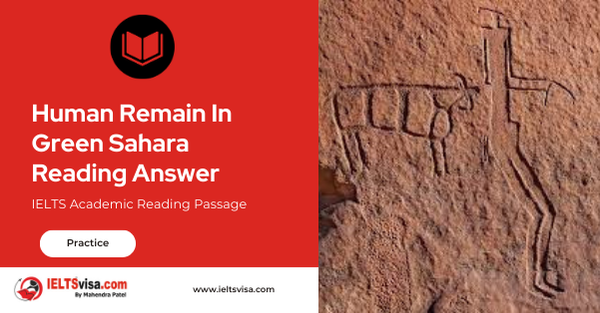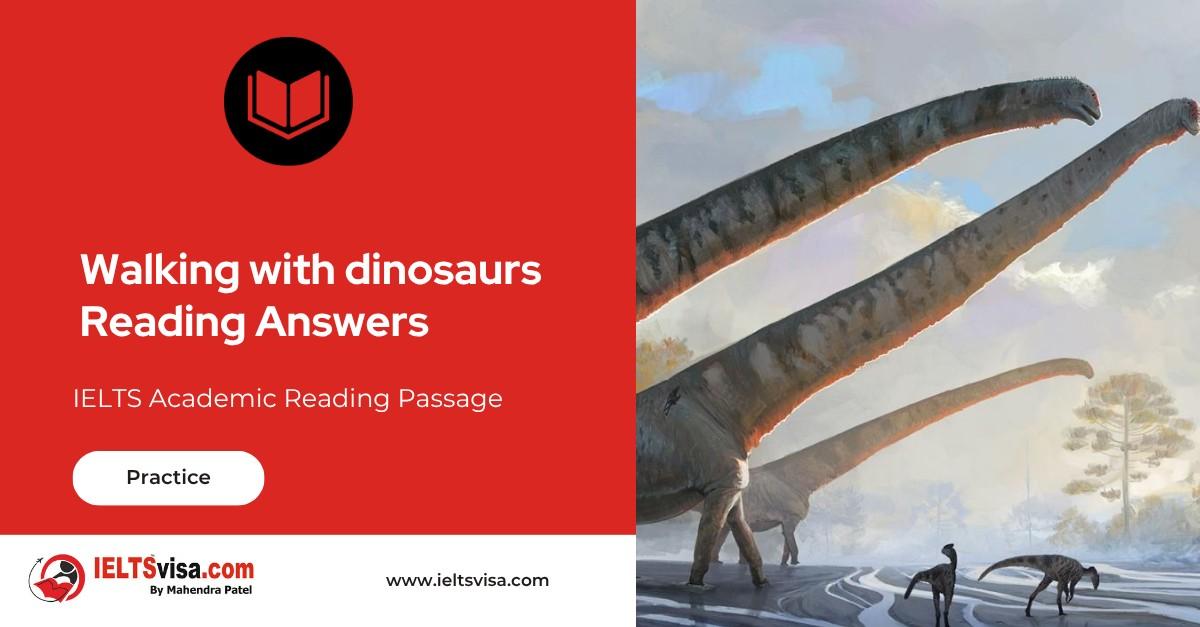Human Remain In Green Sahara Reading Answer
IELTS Academic Reading Passage
{A} On October 13,2,000, a small team of paleontologists led by Paul Sereno of the University of Chicago clambered out of three battered Land Rovers, filled their water bottles, and scattered on foot across the toffee-colored sands of the Tenere desert in northern Niger. The Tenere , on the southern flank of the Sahara, easily ranks among the most desolate landscapes on Earth. The Tuareg , turbaned nomads who for centuries have ruled this barren realm, refer to it as a “desert within a desert”-a California-size ocean of sand and rock, where a single massive dune might stretch a hundred miles, and the combination of 120-degree heat and inexorable winds can wick the water from a human body in less than a day. The harsh conditions, combined with intermittent conflict between the Tuareg and the Niger government, have kept the region largely unexplored.
{B} Mike Hettwer, a photographer accompanying the team, headed off by himself toward a trio of small dunes. He crested the first slope and stared in amazement. The dunes were spilling over with bones. He took a few shots with his digital camera and hurried back to the Land Rovers. “I found some bones:’ Hettwer said, when the team had regrouped. “But they’re not dinosaurs. They’re human.”
{C} In the spring of 2005 Sereno contacted Elena Garcea, an archaeologist at the University of Cassino, in Italy, inviting her to accompany him on a return to the site. Garcea had spent three decades working digs along the Nile in Sudan and in the mountains of the Libyan Desert, and was well acquainted with the ancient peoples of the Sahara. But she had never heard of Paul Sereno. His claim to have found so many skeletons in one place seemed far fetched, given that no other Neolithic cemetery contained more than a dozen or so. Some archaeologists would later be skeptical; one sniped that he was just a “moonlighting paleontologist.” But Garcea was too intrigued to dismiss him as an interloper. She agreed to join him.
{D} Garcea explained that the Kiffian were a fishing-based culture and lived during the earliest wet period, between 8,000 and 10,000 years ago. She held a Kiffian sherd next to a Tenerian one. “What is so amazing is that the people who made these two pots lived more than a thousand years apart.”
{E} Over the next three weeks, Sereno and Garcea-along with five American excavators, five Tuareg guides, and five soldiers from Nigeria’s army, sent to protect the camp from bandits—made a detailed map of the site, which they dubbed Gobero, after the Tuareg name for the area. They exhumed eight burials and collected scores of artifacts from both cultures. In a dry lake bed adjacent to the dunes, they found dozens of fishhooks and harpoons carved from animal bone Apparently the Kiffian fishermen weren’t just going after small fry: Scattered near the dunes were the remains of Nile perch, a beast of a fish that can weigh nearly 300 pounds, as well as crocodile and hippo bones.
{F} Sereno flew home with the most important skeletons and artifacts and immediately began planning for the next field season. In the meantime, he carefully removed one tooth from each of four skulls and sent them to a lab for radiocarbon dating. The results pegged the age of the tightly bundled burials at roughly 9,000 years old, the heart of the Kiffian era. The smaller “sleeping” skeletons turned out to be about 6,000 years old, well within the Tenerian period. At least now the scientists knew who was who.
{G} In the fall of 2006 they returned to Gobero, accompanied by a larger dig crew and six additional scientists. Garcea hoped to excavate some 80 burials, and the team began digging. As the skeletons began to emerge from the dunes, each presented a fresh riddle, especially the Tenerian. A male skeleton had been buried with a finger in his mouth.
{H} Even at the site, Arizona State University bio archaeologist Chris Stojanowski could begin to piece together some clues. Judging by the bones, the Kiffian appeared to be a peaceful, hard working people. “The lack of head and forearm injuries suggests they weren’t doing much fighting,” he told me. “And these guys were strong.” He pointed to a long, narrow ridge running along a femur. “That’s the muscle attachment,” he said. “This individual had huge leg muscles, which means he was eating a lot of protein and had a strenuous lifestyle — both consistent with a fishing way of life.” For contrast, he showed me the femur of a Tenerian male. The ridge was barely perceptible. “This guy had a much less strenuous lifestyle,” he said, “which you might expect of a herder.”
{I} Stojanowski’s assessment that the Tenerian were herders fits the prevailing view among scholars of life in the Sahara 6,000 years ago, when drier conditions favored herding over hunting. But if the Tenerian were herders, Sereno pointed out, where were the herds? Among the hundreds of animal bones that had turned up at the site, none belonged to goats or sheep, and only three came from a cow species. “It’s not unusual for a herding culture not to slaughter their cattle, particularly in a cemetery, M Garcea responded, noting that even modern pastoralists, such as Niger’s Wodaabe, are loath to butcher even one animal in their herd. Perhaps, Sereno reasoned, the Tenerian at Gobero were a transitional group that had not fully adopted herding and still relied heavily on hunting and fishing.
{J} Back in Arizona, Stojanowski continues to analyze the Gobero bones for clues to the Green Saharans’ health and diet. Other scientists are trying to derive DNA from the teeth, which could reveal the genetic origins of the Kiffian and Tenerian- and possibly link them to descendants living today. Sereno and Garcea estimate a hundred burials remain to be excavated. But as the harsh Tenere winds continue to erode the dunes, time is running out. “Every archaeological site has a life cycle,” Garcea said. “It begins when people begin to use the place, followed by disuse, then nature takes over, and finally it is gone. Gobero is at the end of its life.”
Questions 1-3
Do the following statements agree with the information given in the Reading Passage? In boxes 1-3 on your answer sheet, write
TRUE if the statement is True FALSE if the statement is false
NOT GIVEN If the information is not given in the passage
- Hettwer accidentally found human remains in the desert.
- Sereno and Garcea have cooperated in some archaeological activities before.
- The pictures of rock engravings found in Green Sahara is similar to other places.
Questions 4-7
Answer the questions below.
Choose NO MORE THAN THREE WORDS AND/OR A NUMBER from the passage for each answer.
{4} What did Sereno and Garcea produce in the initial weeks before digging work?
4………………..
{5} For what purpose did Sereno send one tooth from each of four skulls to the laboratory?
5………………..
{6} How old are the bigger tightly bundled burials being identified? 6…………………
{7} What part of the body remains did the scientists send for inspection to find out the genetic origins of the Kiffian and Tenerian? 7…………………
Questions 8-14
Summary Complete the following summary of the paragraphs of Reading Passage, using no more than two words from the Reading Passage for each answer. Write your answers in boxes 8-14 on your answer sheet.
On the basis of bone judgment, kiffican seemed to be 8……………… hardworking people, becau find 9……………… on head and forearm.
Through observation of the huge leg muscles, it can be inferred that their diet had plenty of 10…………. and their lifestyle was 11……………… All evidence pointed to compliance with a fishing way of li
On the other hand, Stojanowski presumed that Tenerian preferred to live on herding over 12…………………….. only some animal bones such as 13………………were found, which Sereno supposed that Tene
lived in a 14……………… group at that time.

Solution for: Human remain in Green Sahara Reading Answer
| 1. TRUE | 8. PEACEFUL |
| 2. FALSE | 9. INJURIES |
| 3. NOT GIVEN | 10. PROTEIN |
| 4. A MAP | 11. STRENUOUS |
| 5. RADIOCARBON DATING | 12. HUNTING |
| 6. 9000 years | 13. COW SPECIES |
| 7. TEETH | 14. TRANSITIONAL |
Review and Practice
- Regularly practice with IELTS reading samples and time yourself to get used to the pressure of the exam.
- Review your mistakes to understand where you went wrong and how to avoid similar errors in the future.
Our Books
Master IELTS Speaking Part 1
IELTS Writing Task 1 Book
IELTS Writing Task 2 Book
Human Remain In Green Sahara Reading Answer Explanation
Comin Soon
Practice IELTS Other Modules
IELTS Listening
The IELTS Listening test assesses how well you can understand spoken English in various contexts. It lasts about 30 minutes and is divided into four sections with a total of 40 questions. The listening tasks become increasingly difficult as the test progresses.
IELTS Academic Reading
The IELTS Academic Reading section assesses your ability to understand and interpret a variety of texts in academic settings. It is designed to evaluate a range of reading skills, including skimming for gist, reading for main ideas, reading for detail, understanding inferences, and recognizing a writer's opinions and arguments.
IELTS Speaking
The IELTS Speaking test assesses your ability to communicate in English on everyday topics. It lasts 11-14 minutes and consists of three parts: introduction, cue card, and a discussion based on the cue card topic.
IELTS General Reading
IELTS General Reading tests your ability to understand and interpret various types of texts. Here are some key areas and types of content you can expect to encounter in the reading section, along with tips for effective preparation.
IELTS Academic Writing Task 1
In IELTS Academic Writing Task 1, you are presented with a visual representation of information, such as graphs, charts, tables, or diagrams, and you are required to summarize, compare, or explain the data in your own words.
IELTS General Writing Task 1
In IELTS General Writing Task 1, you are required to write a letter based on a given situation. The letter can be formal, semi-formal, or informal, depending on the prompt. Here’s a breakdown of the key components to include in your letter
IELTS Academic Writing Task 2
In IELTS Academic Writing Task 2, you are required to write an essay in response to a question or topic. Here’s a guide to help you understand the essential elements of this task
IELTS Exam Tips
To succeed in the IELTS exam, practice regularly, familiarize yourself with the test format, improve your vocabulary, develop time management skills, and take mock tests to build confidence.
Grammer for IELTS
Grammar is the foundation of effective communication in English. Understanding tense usage, subject-verb agreement, and sentence structure enhances clarity and coherence in writing and speaking.
Vocabulary for IELTS
Vocabulary plays a crucial role in the IELTS (International English Language Testing System) exam, especially in the Speaking and Writing sections. Here’s an overview of why vocabulary is important and how it impacts your performance
RECENT IELTS SAMPLES QUESTIONS AND ANSWERS
Walking with dinosaurs
Peter L. Falkingham and his colleagues at Manchester University are developing techniques that...
Money as the Unit of Amount Reading Answers
The most difficult aspect of money to understand is its function as a unit of account. In...
WEATHERING IN THE DESERT
In the deserts, as elsewhere, rocks at the earth's surface are changed by weathering, which...
Nature on Display in American Zoos
The first zoo in the United States opened in Philadelphia in 1874, followed by the Cincinnati...
Can We Prevent the Poles From Melting
Such is our dependence on fossil fuels, and such is the volume of carbon dioxide we have...
Air conditioning the earth reading answers
The circulation of air in the atmosphere is activated by convection, the transference of heat...













